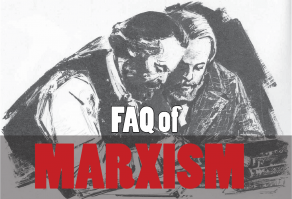What is value? This question has perplexed the human mind for more than 2,000 years. The classical bourgeois economists grappled with the question, as did Marx. After much deliberation, they correctly hit upon the idea that labor was the source of value. This, then, became a cornerstone of bourgeois political economy, beginning with Adam Smith. On this question, there was common ground between Marx and the classical bourgeois economists.
 However, for the bourgeois economists it nevertheless presented a paradox and a blind alley. “The man who found the way out of this blind alley was Karl Marx,” explained Friedrich Engels. For Marx, who went on to further develop and elaborate the theory of value, it was the means to discovering of the laws of motion of capitalism and the discovery of surplus value. For this reason, the theory of value has become the principal target for all opponents of Marx. “The stock-in-trade of most anti-Marxian writers is the exposition of the absurdities of this doctrine,” statesd A.D. Lindsay, the former Master of Balliol College, Oxford, in 1931.
However, for the bourgeois economists it nevertheless presented a paradox and a blind alley. “The man who found the way out of this blind alley was Karl Marx,” explained Friedrich Engels. For Marx, who went on to further develop and elaborate the theory of value, it was the means to discovering of the laws of motion of capitalism and the discovery of surplus value. For this reason, the theory of value has become the principal target for all opponents of Marx. “The stock-in-trade of most anti-Marxian writers is the exposition of the absurdities of this doctrine,” statesd A.D. Lindsay, the former Master of Balliol College, Oxford, in 1931.
What is the source of wealth?
The idea that all wealth is created by human labor is certainly not a new idea. It can be traced to the Middle Ages in John Ball’s sermon, and was a central idea among the communist sects in the English Civil War. “But rich men receive all they have from the laborer’s hand, and what they give, they give away other men’s labors, not their own; therefore they are not righteous actors in the earth,” stated the Diggers’ leader Gerrard Winstanley in 1652. The leader of the London Jacobins, John Thelwall, proclaimed, “Property is nothing but human labor.” And Benjamin Franklin, the American renaissance man, wrote that, “Trade in general being nothing else but the exchange of labor for labor, the value of all things is justly measured by labor.”
One may add that labor is not the only source of material wealth, of the use-values produced by labor. The proceeds of nature, which we receive as a free gift, also contribute to this wealth. As William Petty correctly observed, labor is the father of wealth and the earth its mother.
Today, the labor theory of value has become distinctly heretical in bourgeois circles, not least because of its revolutionary implications. Initially, the labor theory of value was a very useful weapon to the bourgeoisie, when, as a progressive class, they used it to strike blows against the politically powerful landowning class. Once the battle was won, however, the bourgeoisie no longer had use for this theory. In fact, for the bourgeois, it had subversive connotations which had to be discredited. “That labor is the sole source of wealth,” wrote John Cazenove in 1812, “seems to be a doctrine as dangerous as it is false, as it unhappily affords a handle to those who would represent all property as belonging to the working classes, and the share which is received by others as a robbery or fraud upon them.”
Labor theory of value
The theory of value is straightforward enough. Human beings can only live and satisfy their basic needs through labor. Of course, this can take the form of an exploiting class living off the labor of others.
“Every child knows that any nation that stopped working, not for a year, but let us say, just for a few weeks, would perish,” stated Marx. Broadly speaking, things have to be produced in certain quantities and then distributed according to the needs of society. This constitutes the economic laws of all societies, including our own. “And every child knows, too, that the amounts of products corresponding to the differing amounts of needs, demand differing and quantitatively determined amounts of society’s aggregate labor,” continued Marx.
In order to satisfy human needs, the labor of society, no matter what the specific form of social production, whether it be primitive communism, slavery, feudalism, capitalism, or socialism, has to be divided according to these basic requirements. Of course, the form by which this takes place differs from one social system to another. “Natural laws cannot be abolished at all. The only thing that can change, under historically differing conditions, is the form in which those laws assert themselves,” Marx explained. Furthermore, “Labor, then, as the creator of use values, as useful labor, is a condition of human existence which is independent of all forms of society; it is an eternal natural necessity which mediates the metabolism between man and nature, and therefore human life itself.”
In a non-industrialized natural economy, producers produce use values for the needs of the local community; but over time, the market becomes dominant, and those producers now produce commodities, not for use, but for exchange. Everyone therefore becomes dependent on one another due to the division of labor, i.e., because everyone needs the products produced by others. The exchange of commodities—based on an exchange of equivalents—takes place on the basis of a common quality, irrespective of the commodities’ different physical properties. The common quality is that they are values.
Just as the weight of an object can only be understood in relation to another object, so the value of a commodity can only be understood when it is actually exchanged for another. For this exchange to happen there needs to be a quality existing in common within all commodities that can be compared, one to another. This is clearly not weight, color, size, or any other physical quality, which vary considerably from one commodity to another. What commodities have in common is that they are all products of human labor.
“Nature builds no machines, no locomotives, railways, electric telegraphs, self-acting mules, etc. These are products of human industry,” explained Marx. As a consequence, so much generalized labor in one commodity can be compared with so much generalized labor in another. In exchange, so many watches can be traded for so many pairs of shoes, depending on the quantity of labor time involved in their production. Commodities can therefore be regarded as congealed labor time.
Reality and appearance
For Marx, value is a relationship between persons who produce commodities, a social relationship, but it appears in a “fantastic form” as a relation between things. It is people alone, with their own interests, who engage in this process, using these inanimate objects for sale, and not the other way round. This confusion arises from what Marx calls “the fetishism of commodities.” As we know, appearances can be deceptive. Each day the sun appears to circumvent the earth, when the reality is the earth travels around the sun. We therefore need to penetrate the appearance to reveal the reality that is disguised within. That is the reason for Marxist economic theory.
Again, in Marx’s own words: “The vulgar economist has not the slightest idea that the actual everyday exchange relations and the value magnitudes cannot be directly identical. The point of bourgeois society is precisely that, a priori, no conscious social regulation of production takes place. What is reasonable and necessary by nature asserts itself only as a blindly operating average. The vulgar economist thinks he has made a great discovery when, faced with the disclosure of the intrinsic interconnection, he insists that things look different in appearance. In fact, he prides himself in his clinging to appearances and believing them to be the ultimate. Why then have science at all?
“But there is also something else behind it. Once interconnection has been revealed, all theoretical belief in the perpetual necessity of the existing conditions collapses, even before the collapse takes place in practice. Here, therefore, it is completely in the interests of the ruling classes to perpetuate the unthinking confusion. And for what other reason are the sycophantic babblers paid who have no other scientific trump to play except that, in political economy, one may not think at all!”
Value, in the Marxist sense, appears a rather strange thing. It is neither a natural or physical quality of the commodity, nor one that can be understood through our senses. Such value cannot be seen, even with a powerful microscope. Neither can it be touched or smelled, as it has no physical presence. But exchange value certainly exists and is not an arbitrary quality. As Marx explained, value is a definite social quality and only appears when exchange takes place between commodities. It is a social quality, a relationship between the labor of the producers. The law of supply and demand simply pivots the market prices of commodities around their value.
Value is the result, however, not of a particular form of labor, but of abstract human labor, labor in general. The labor embodied in different commodities, such as shoes and coats, is different. They are the specific products of the shoemaker and the tailor. However, in exchange, what is exchanged is not the particular labor, but human labor in general, abstract human labor. All labor, whether simple, unskilled, average labor, or skilled labor, is all reduced to quantities of average labor; skilled labor being simply a multiple of unskilled.
In the process of production, machines do not create new value, which at first sight appears to be the case. Rather, they serve simply to transfer their own value bit by bit to the new commodities, namely, through depreciation. Machines have to be put to use by workers, otherwise they are wasted. “A machine which is not active in the labor process is useless,” explained Marx. “In addition, it falls prey to the destructive power of natural processes. Iron rusts; wood rots. Yarn with which we neither weave nor knit is cotton wasted. Living labor must seize on these things, awaken them from the dead, change them from merely possible into real and effective use values.”
Marx went on to answer the common objection about a lazy worker who appears to produce greater values, having spent more time in producing them. Marx explained that it was not merely labor that created value, but “socially necessary” labor, a distinction the classical economists failed to grasp. By this is meant the average labor used to produce goods under average conditions and under the existing level of technique. Whether a commodity contains socially necessary labor or not will be revealed in exchange as commodities are sold or rejected on the market. If it takes longer to produce a certain commodity than the average time, then this excessive labor time is useless labor. Market competition will force down prices to the costs of the social average. All those commodities made at a higher cost will remain unsold or have to be sold below their cost of production. Production costs are ultimately reduced to labor costs. The ebb and flow of price levels settles around an axis which covers production cost and a certain rate of profit. Our capitalist employing unproductive labor will soon find himself driven out of business, unable to sell his goods at the “going rate.”
If capitalists are able to produce commodities at below the going rate, by lowering the cost of production, then they will be able to sell more goods more cheaply and make superprofits—until everyone else follows suit and introduces the new technique. Once this happens, the price falls to a new level to correspond with the new “socially necessary” labor time. Each commodity now takes less time to produce and therefore contains less value than before, thereby effectively reducing the cost and the price. The socially-necessary labor time, of course, changes with different times and places, but there is a general average standard at any given time. Through this process is determined the ratio of commodities necessary for society, and the distribution of labor power to the various sectors of the economy. This shows how the law of value acts as the basic regulator of the capitalist system.
The need to constantly keep up with “socially necessary” labor time also explains why capitalism cannot exist without continually revolutionizing the mode of production and increasing exploitation. The introduction of machinery, together with an expansion of capital, means an inevitable tendency towards the concentration and centralization of capital and the rise of monopolies.
The arguments of the apologists of capitalism have become increasingly discredited. The reformists, who also attempt to ridicule the labor theory of value, have long ago capitulated to capitalism and act as its open apologists. But their ideas are out of step with today’s reality, as living standards collapse in an age of austerity. The crisis of capitalism means the crisis of reformism, as well as bourgeois economics, on which they base themselves. The crisis, which has assumed a protracted, insoluble character, forces the working class to look for a way out of this mess and gravitate towards those who can offer a coherent explanation.
Only Marxism can offer this alternative, based upon a scientific view of the world, as well as the solution in the revolutionary overthrow of capitalism. In the final analysis, this is the reason why Marxism is in a continual struggle against the defenders of an outmoded system and ideology.


